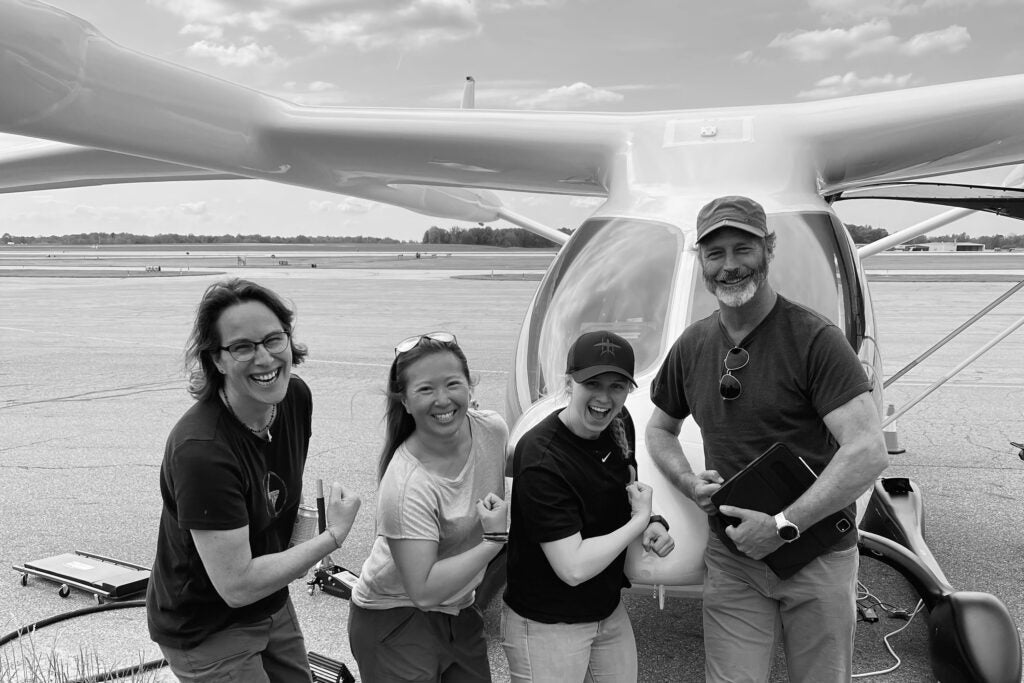In a remarkable milestone for an electric aircraft, Beta Technologies has flown its Alia test demonstrator on an eight-leg cross-country mission across six states totaling 1,219 nm.
“It’s not something that I know has been done previously, and it will be the first time that our aircraft has done it,” said Beta flight test engineer Emma Davis in a company video. “So it’s a huge step forward showing that it is a viable future to have an electric aircraft that can travel long ranges, not just short hops.”
A single pilot flew each leg of the mission, Beta said, rotating between two flight-test pilots—Lochie Ferrier and Camron (Arlo) Guthrie. “We’ve done a lot of rehearsal, a lot of preparation, a lot of flying, a lot of simulating, and so we were really confident that we’re ready to go,” Guthrie said in Beta’s video.
The weeklong mission departed from Plattsburgh, New York’s Plattsburgh International Airport (KPBG) on May 23, making eight stops to recharge the aircraft’s batteries before landing in Arkansas, at Bentonville Municipal Airport (KVBT) last Monday. Total time in the air: 11 hours, 44 minutes.
“In three years, we’ve come from testing inverters in the corner of a hangar to actually flying across the country,” said test flight team member Manon Belzile in the video. “It’s like a dream come true.”
It’s the latest success for Beta’s unique aircraft, which is designed to operate as an electric vertical takeoff and landing (eVTOL). Beta currently operates two prototypes – SN1, which is configured for conventional takeoff and landing (CTOL) testing and another aircraft which is configured for eVTOL, now undergoing hover testing in Burlington. For this flight, Beta flew SN1.
In March, Alia became the first electric aircraft flown by U.S. Air Force pilots as part of its Agility Prime technology acceleration program.
Alia has a carbon-fiber fuselage and battery-powered motors that drive a single, rear-mounted pusher propeller. Alia’s speed: About 150 knots. Maximum takeoff weight: 6,999 pounds. Payload capacity: 1,400 pounds. Range: 250 nm. FAA type certification for Alia is expected by 2024.
Envelope Expansion
Beta said the project largely was an attempt to push Alia’s flight test program forward after months of expanding the aircraft’s test envelope. “We have completed a few hundred successful and informative test flights in our home airspace,” Beta said in a statement. Test pilots recently flew a direct route over the Green Mountains from Manchester-Boston Regional Airport (KMHT) to Burlington International Airport (KBTV) and from KBTV to Rutland, Vermont.
Accompanied by a Cessna Caravan flying chase, Alia’s crew charged the aircraft’s batteries using Beta’s multi-modal charging stations at four stops. Part of the mission included an opportunity to demonstrate the company’s larger business plan to build a network of electric charging stations for electric vehicles as well as aircraft across the nation.
With recently spiking prices for aviation fuel, Beta reported its cost for an electric recharge was $19 for a 160 nm leg of the voyage. Compare that with the mission’s Cessna Caravan chase airplane, which required $800 in fuel for the same leg. The Alia is designed to fully recharge in less than an hour.
Following certification, Beta intends to focus its first production models on a cargo variant and has already received orders from UPS Flight Forward (NYSE:UPS), Blade Urban Air Mobility (NASDAQ:BLDE). Alia’s launch customer will be United Therapeutics, which plans to use the aircraft to transport organs for human transplantation.

Beta’s Cross-Country Flight Log
Beta shared details about the flight with FLYING, including times, distances, and duration. All times are local for the time zone of the airport. Legs in which Alia crossed a time zone are noted.
KPBG to KRME—Rome, New York (Monday, May 23)
- Takeoff: 8:56 a.m.
- Distance: 144 nm
- Duration: 76 min.
- Landing: 10:13 a.m.
KRME to KDDK—Dunkirk, New York (Monday, May 23)
- Takeoff: 5:44 p.m.
- Distance: 184 nm
- Duration: 108 min.
- Landing: 7:32 p.m.
KDDK to KCAK—Akron, Ohio (Tuesday, May 24)
- Takeoff: 11:13 a.m.
- Distance: 147 nm
- Duration: 81 min.
- Landing: 12:34 p.m.
KCAK to KSGH—Springfield, Ohio (Tuesday, May 24)
- Takeoff: 5:07 p.m.
- Distance: 138 nm
- Duration: 83 min.
- Landing: 6:29 p.m.
KSGH to KBMG—Bloomington, Indiana (Saturday, May 28)
- Takeoff: 3:11 p.m.
- Distance: 145 nm
- Duration: 91 min.
- Landing: 4:42 p.m.
KBMG to KMWA—Marion, Illinois (Sunday, May 29)
- Takeoff: 8:13 a.m. EST
- Distance: 144 nm
- Duration: 86 min.
- Landing: 8:42 a.m. CST (9:42 EST)
KMWA to KUNO—West Plains, Missouri (Sunday, May 29)
- Takeoff: 4:07 p.m.
- Distance: 171 nm
- Duration: 94 min.
- Landing: 5:41 p.m.
KUNO to KVBT—Bentonville, Arkansas (Monday, May 30)
- Takeoff: 5:56 p.m.
- Distance: 146 nm
- Duration: 86 min.
- Landing: 7:22 p.m.




